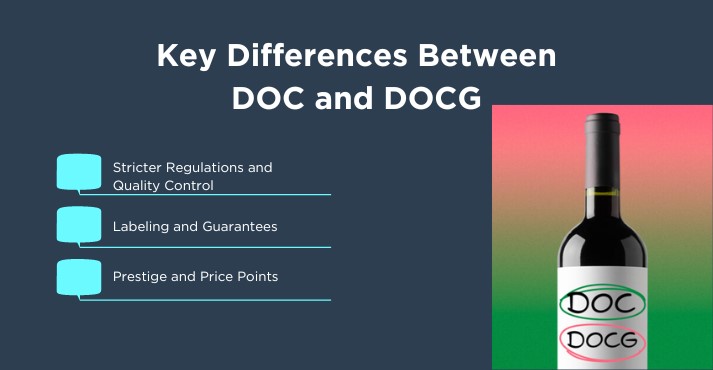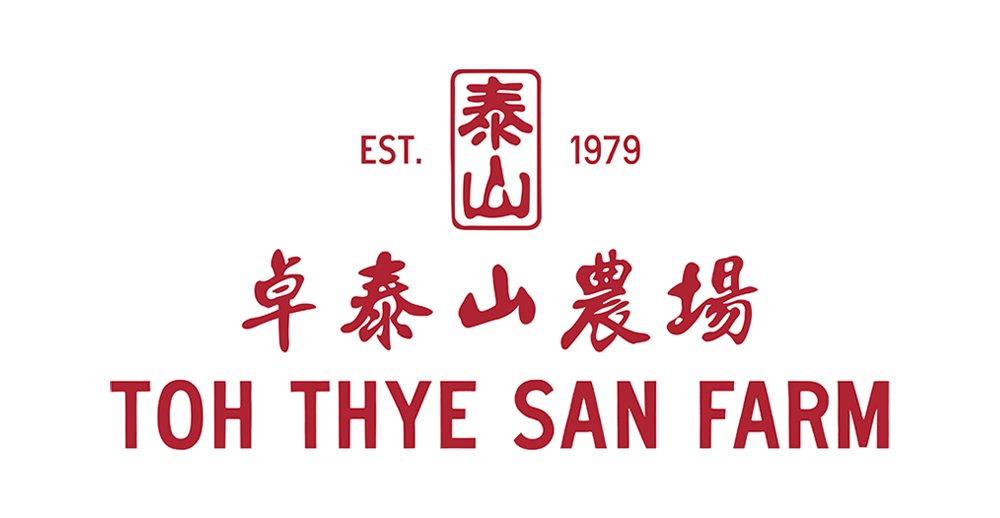Understanding classifications can make a significant difference in selecting the best products for your business in the wine world.
Among the most crucial classifications are DOC (Denominazione di Origine Controllata) and DOCG (Denominazione di Origine Controllata e Garantita), both of which signify quality and authenticity in Italian wines.
Understanding how to read a wine label ensures the perfect wine pairing and a clear indication of wine classification. Additionally, it ascertains the highest standards in production, which is vital for maintaining customer satisfaction and building a reputable wine list.
For those in the wine industry, from retailers to restaurateurs, recognizing the difference between DOC vs. DOCG wine can help make informed purchasing decisions.
DOC wines adhere to strict production regulations that guarantee the wine’s origin and quality. DOCG wines take it a step further, with even more strict controls and a guarantee of superior quality.
This distinction can be a valuable selling point, assuring your customers that they are getting the best of what Italian wine regions offer.
Incorporating DOC and DOCG wines into your inventory enhances the quality of your offerings. It boosts your credibility as a purveyor of fine wines.
Understanding these classifications is essential for anyone looking to thrive in the competitive wine market.
What Are Italian Wine Label Classifications?

Italian wine label classifications are crucial to the country’s wine industry and are designed to ensure quality and authenticity.
The primary classifications are DOC (Denominazione di Origine Controllata) and DOCG (Denominazione di Origine Controllata e Garantita).
These labels indicate that the wine meets specific standards regarding its origin, grape varieties, production methods, and overall quality.
They provide a framework that helps producers adhere to traditional methods and high standards, ensuring that consumers receive a product that reflects the true character of its region.
These classifications are invaluable tools for both consumers and professionals. They help in making informed choices by clearly indicating the wine’s quality and origin.
This not only aids in selecting wines that meet specific criteria but also enhances trust and credibility in the products being offered.
Italian Wine Label Classifications
Italian wine label classifications are essential for understanding the quality and origin of wines produced in Italy.
There are four primary classifications: Vino da Tavola (VDT), Indicazione Geografica Tipica (IGT), Denominazione di Origine Controllata (DOC), and Denominazione di Origine Controllata e Garantita (DOCG).
Each classification represents a different level of quality control and geographic specificity, providing valuable information for consumers and wine industry professionals.
Vino da Tavola (VDT)

Vino da Tavola (VDT) is the primary Italian wine classification system classification. These are typically everyday table wines that do not adhere to the strict regulations required for higher classifications.
The regulations for VDT wines are minimal, allowing producers considerable flexibility in grape varieties and production methods.
The labeling requirements for VDT wines are also basic. They usually include only the wine’s color and the producer’s name without specifying the vintage or grape variety.
VDT wines are often made from a blend of grapes from various regions, resulting in a wide range of flavors and styles. These wines are generally less expensive and intended for casual consumption.
Typical VDT wines include natural wines and simple reds and whites for everyday meals and casual gatherings.
While they may not carry the prestige of higher classifications, VDT wines offer an accessible entry point into Italian wine.
Indicazione Geografica Tipica (IGT)

Indicazione Geografica Tipica (IGT) is an intermediate classification that provides more specific information about the wine’s geographic origin.
Introduced in 1992, the IGT classification was created to offer greater flexibility than DOC and DOCG, allowing winemakers to experiment with non-traditional grape varieties and production methods while ensuring a certain quality and regional identity.
To qualify for IGT status, a wine must meet specific criteria related to its geographic origin, grape varieties, and production methods.
This classification includes international grape varieties that may not be permitted under stricter DOC or DOCG regulations. As a result, IGT wines can offer a unique blend of tradition and innovation.
Notable IGT regions include Toscana (Tuscany), where famous “Super Tuscan” wines such as Tignanello and Sassicaia are produced.
These wines often combine traditional Italian grapes like Sangiovese with international varieties like Cabernet Sauvignon and Merlot.
IGT wines provide an excellent balance between quality and creativity, appealing to both wine enthusiasts and casual drinkers.
Denominazione di Origine Controllata (DOC)

Denominazione di Origine Controllata (DOC) is a higher classification than IGT. It represents wines that meet strict regulations regarding geographic origin, grape varieties, production methods, and aging requirements.
The DOC classification was introduced in 1963 to protect the integrity of Italian wines and ensure that they reflect the traditional characteristics of their regions.
To be designated as DOC, a wine must adhere to specific criteria that guarantee its quality and authenticity.
This includes restrictions on the geographic area where the grapes are grown, the types of grapes used, and the methods of production and aging.
These regulations are designed to preserve the unique characteristics of each wine region and maintain consistent quality standards.
Examples of DOC wines and regions in Italy include Chianti DOC from Tuscany, Barolo DOC from Piedmont, Valpolicella DOC from Veneto, and Grüner Veltliner.
These wines are renowned for their distinctive flavors and high quality, making them popular among enthusiasts and professionals.
Denominazione di Origine Controllata e Garantita (DOCG)

Denominazione di Origine Controllata e Garantita (DOCG) is the highest classification in the Italian wine classification system, representing the pinnacle of quality and authenticity.
Introduced in 1980, the DOCG classification was established to provide additional quality assurance for Italy’s finest wines.
To qualify for DOCG status, a wine must meet even stricter regulations than those required for DOC. This includes rigorous quality control measures, such as tasting panels and guarantee of origin and quality.
DOCG wines must also undergo strict production and aging requirements to meet the highest standards.
Examples of DOCG wines and regions in Italy include Brunello di Montalcino DOCG from Tuscany, Barbaresco DOCG from Piedmont, and Amarone della Valpolicella DOCG from Veneto.
These wines are celebrated for their exceptional quality, complexity, and ability to age gracefully, making them highly sought after by collectors and connoisseurs.
Incorporating DOC and DOCG wines into your inventory enhances the quality of your offerings and boosts your credibility as a purveyor of fine wines.
Understanding these classifications is essential for anyone looking to thrive in the competitive wine market.
Key Differences Between DOC and DOCG

The DOC (Denominazione di Origine Controllata) and DOCG (Denominazione di Origine Controllata e Garantita) classifications are integral to the Italian wine industry. Each represents different levels of quality and regulation.
Understanding the key differences between these two classifications can help wine industry professionals make informed purchasing and inventory decisions.
Stricter Regulations and Quality Control
One of the most significant differences between DOC and DOCG wines lies in the stringency of their regulations. DOC wines must adhere to specific criteria related to geographic origin, grape varieties, production methods, and aging requirements.
These regulations ensure that DOC wines maintain a high level of quality and authenticity, reflecting the traditional characteristics of their regions.
DOCG wines, on the other hand, face even stricter regulations. To qualify for DOCG status, wines must undergo more rigorous production and aging processes.
This includes additional quality control measures, such as mandatory tasting panels that evaluate the wine’s quality before it can be labeled as DOCG.
These panels are conducted by government-appointed experts who ensure that each wine meets the highest standards.
The guarantee of quality and origin provided by DOCG wines is a significant differentiator, assuring consumers and professionals of their exceptional quality.
Labeling and Guarantees
The labeling requirements for DOC and DOCG wines also highlight their differences. DOC wines are labeled to indicate their geographic origin, grape varieties, and other relevant information. This labeling helps consumers identify the wine’s provenance and quality level.
DOCG wines go a step further by providing additional guarantees on their labels. The DOCG label includes a numbered government seal, certifying that the wine has passed all quality control measures and meets the strict DOCG standards.
This seal is a mark of authenticity and quality, offering consumers an added confidence level in their purchase.
Prestige and Price Points
Due to the stricter regulations and higher quality control standards, DOCG wines generally carry higher prestige and price points than DOC wines.
The meticulous production processes and rigorous evaluations contribute to the superior quality of DOCG wines, which makes them highly sought after by collectors, connoisseurs, and wine industry professionals.
The higher price points of DOCG wines reflect their exceptional quality and limited production. These wines are often produced in smaller quantities and undergo longer aging, resulting in complex flavors and excellent aging potential.
The prestige associated with DOCG wines makes them valuable additions to any wine list and enhances the reputation of retailers and restaurateurs who offer them.
While both DOC and DOCG classifications represent high-quality Italian wines, the DOCG classification stands out for its stricter regulations, rigorous quality control, and added guarantees.
These factors contribute to the higher prestige and price points of DOCG wines, making them a worthwhile investment for anyone looking to offer the best of Italian wines.
Understanding these differences is essential for professionals in the wine industry to make informed choices and build a reputable wine selection.
Frequently Asked Questions (FAQs)
Is DOCG better than DOC?
DOCG wines are generally considered better than DOC wines due to stricter regulations, higher quality control standards, and additional guarantees of origin and quality. This often results in superior quality and higher prestige for DOCG wines.
Is Chianti DOC or DOCG?
Chianti wines can be both DOC and DOCG. The basic Chianti falls under the DOC classification, while Chianti Classico, produced in the traditional heartland of the Chianti region, is designated as DOCG, indicating a higher quality.
Is DOCG wine sweet?
DOCG wines are not necessarily sweet; they can range from dry to sweet depending on the specific type and production methods. The DOCG classification focuses on quality and origin rather than sweetness.
Conclusion
Understanding the distinctions between DOC vs. DOCG wine classifications is crucial for anyone in the wine industry.
These classifications help ensure the quality and authenticity of Italian wines, with DOCG representing the highest level of scrutiny and excellence.
DOC wines already meet high standards, guaranteeing a reliable level of quality and regional authenticity.
DOCG wines, however, go beyond these standards with stricter regulations and rigorous quality control measures, often resulting in superior quality, higher prestige, and higher price points.
Incorporating DOC and DOCG wines into your inventory can enhance your offerings and cater to various consumer preferences and budgets.
While DOC wines provide excellent quality at more accessible price points, DOCG wines offer a mark of distinction for discerning customers seeking the best Italy has to offer.
Understanding these classifications can help you make more informed decisions, ensuring that your selection of Italian wines stands out for its quality and authenticity.





























